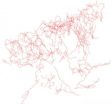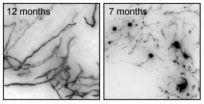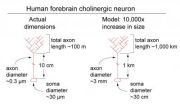(Press-News.org) By studying laboratory mice, scientists at The Johns Hopkins University have succeeded in plotting the labyrinthine paths of some of the largest nerve cells in the mammalian brain: cholinergic neurons, the first cells to degenerate in people with Alzheimer's disease.
"For us, this was like scaling Mount Everest," says Jeremy Nathans, Ph.D., professor of molecular biology and genetics, neuroscience, and ophthalmology at the Johns Hopkins University School of Medicine. "This work reveals the amazing challenges that cholinergic neurons face every day. Each of these cells is like a city connected to its suburbs by a single, one-lane road, with all of the emergency services located only in the city. You can imagine how hard it would be in a crisis if all of the emergency vehicles had to get to the suburbs along that one road. We think something like this might be happening when cholinergic neurons trying to repair the damage done by Alzheimer's disease."
Each cholinergic neuron, Nathans explains, has roughly 1,000 branch points. If lined up end to end, one neuron's branches would add up to approximately 15 times the length of the mouse brain. But all of the branches are connected by a single, extremely thin "pipeline" to one hub — the cell body — that provides for the needs of the branches. The challenge of moving material through this single pipeline could make it very difficult for cholinergic neurons to combat the challenges that come with a disorder like Alzheimer's disease, he says. Now, by mapping the branches and pipelines, scientists will likely get a better fix on what happens when the neurons fail to meet the challenges.
A summary of the research was published online in the journal eLife on May 7.
Cholinergic neurons are among the largest neurons in the mammal brain. Named for their release of a chemical messenger called acetylcholine, they number only in the thousands in mouse brains, a tiny fraction of the 50 to 100 million total neurons. Their cell bodies are located at the base of the brain near its front end, but their branches extend throughout the cerebral cortex, the outermost, wrinkled layer of "grey matter" that is responsible for the mind's most advanced intellectual functions. Therefore, although there are relatively few cholinergic neurons, they affect a very large part of the brain, Nathans says.
Due to the technical challenge of visualizing the complicated paths of hundreds of tiny branches from a single neuron tangled within millions of other neurons, the actual size and shape of individual cholinergic neurons — and the territory they cover — had been unknown until now, Nathans says. Using genetic engineering methods, the Nathans team programmed several cholinergic neurons per mouse to make a protein that could be seen with a colored chemical reaction. Critical to the success of the work was the ability to limit the number of cells making the protein — if all of the cholinergic neurons made the protein, it would have been impossible to distinguish individual branches.
Because microscopes cannot see through thick tissue, Nathans and his team preserved the mouse brains and then thinly sliced them to produce serial images. The branching path of each neuron was then painstakingly reconstructed from the serial images and analyzed. In adult mice, he says, the average length of the branches of a single cholinergic neuron, lined up end to end, is 31 cm (12 inches), varying from 11 to 49 cm (4 to 19 inches). The average length of a mouse brain is only 2 cm — a bit less than one inch. Although each cholinergic neuron, on average, contains approximately 1,000 branch points, they vary significantly in the extent of the territory that they cover.
The researchers used the same techniques to study the cholinergic neurons of mice with a rodent form of Alzheimer's disease and found that the branches were fragmented. They also found clumps of material that may have been debris from the disintegrating branches.
Although the cholinergic neurons of human brains have not been individually traced, Nathans' team was able to calculate that the average cholinergic neuron in the human brain has a total branch length of approximately 100 meters, a bit longer than a football field. "That is a really long pipeline, especially if one considers that the pipes have diameters of only 30 thousandths of a millimeter, far narrower than a human hair," says Nathans.
He adds, "Although our study only defined a few simple, physical properties of these neurons, such as size and shape, it has equipped us to form and test better hypotheses about what goes wrong with them during disease."
INFORMATION:
Other authors of the report include Hao Wu and John Williams of the Johns Hopkins University School of Medicine.
This work was supported by grants from the Human Frontier Science Program, the Howard Hughes Medical Institute and the Brain Science Institute of The Johns Hopkins University.
On the Web:
Link to article in eLife: http://www.dx.doi.org/10.7554/eLife.02444
Nathans Lab: http://nathanslab.mbg.jhmi.edu/
Nathans HHMI Profile: http://www.hhmi.org/scientists/jeremy-nathans
Related stories:
Why Our Backs Can't Read Braille
http://www.hopkinsmedicine.org/news/media/releases/why_our_backs_cant_read_braille
Tangled path of Alzheimer's-linked brain cells mapped in mice
'Transportation' may be at the heart of the disease
2014-06-09
ELSE PRESS RELEASES FROM THIS DATE:
NASA's TRMM satellite analyzes Mexico's soaking tropical rains
2014-06-09
VIDEO:
This movie of NOAA's GOES-East satellite imagery shows the movement of System 90L over land and dissipating between June 6 and June 7 at 2000 UTC (4 p.m. EDT)....
Click here for more information.
The movement of tropical storm Boris into southern Mexico and a nearly stationary low pressure system in the southern Gulf of Mexico caused heavy rainfall in that area. NASA and the Japan Aerospace Exploration Agency's Tropical Rainfall Measuring Mission satellite known as TRMM ...
A new methodology developed to monitor traffic flow
2014-06-09
"If we know not only the volume of the traffic but also the way in which the flow is taking place, we can detect when the traffic is undergoing a significant change. This information can be used, for example, when decisions are taken about signs (traffic lights, directions, etc.), road capacity, and other aspects," explained Fermín Mallor, Prof of the Department of Statistics and Operational Research.
What is new about this research is that it applies the so-called curve statistics to the specific problem of traffic control or monitoring. The use of the methodology is ...
NHAES research: New England lakes recovering rapidly from acid rain
2014-06-09
DURHAM, N.H. – For more than 40 years, policy makers have been working to reduce acid rain, a serious environmental problem that can devastate lakes, streams, and forests and the plants and animals that live in these ecosystems. Now new research funded by the NH Agricultural Experiment Station (NHAES) at the University of New Hampshire College of Life Sciences and Agriculture indicates that lakes in New England and the Adirondack Mountains are recovering rapidly from the effects of acid rain.
Researchers found that sulfate concentration in rain and snow declined by more ...
Angry faces back up verbal threats, making them seem more credible
2014-06-09
We've all been on the receiving end of an angry glare, whether from a teacher, parent, boss, or significant other. These angry expressions seem to boost the effectiveness of threats without actual aggression, according to research published in Psychological Science, a journal of the Association for Psychological Science.
The research findings show that angry expressions lend additional weight to a negotiator's threat to walk away from the table if his or her demands aren't met, leading the other party in the negotiation to offer more money than they otherwise would have.
"Our ...
Distance from a conflict may promote wiser reasoning
2014-06-09
If you're faced with a troubling personal dilemma, such as a cheating spouse, you may think about it more wisely if you consider it as an outside observer would, according to research forthcoming in Psychological Science, a journal of the Association for Psychological Science.
"These results are the first to demonstrate a new type of bias within ourselves when it comes to wise reasoning about an interpersonal relationship dilemma," says psychology researcher and study author Igor Grossmann of the University of Waterloo in Canada. "We call the bias Solomon's Paradox, ...
Penn Medicine at the International Congress of Parkinson's Disease and Movement Disorders
2014-06-09
Penn Medicine researchers will be among the featured presenters at the 18th International Congress of Parkinson's Disease and Movement Disorders in Stockholm, Sweden, from Sunday, June 8 to Thursday, June 12, 2014.
Matthew Stern, MD, director of the Parkinson's Disease and Movement Disorders Center in the Department of Neurology and current president of the International Parkinson's Disease and Movement Disorders Society, will chair a plenary session entitled "New insights into the pathology, progression, and heterogeneity of Parkinson's disease."
John Q. Trojanowski, ...
What causes garlic breath? (video)
2014-06-09
WASHINGTON, June 9, 2014 — Garlic is good for your body, great for your taste buds, but terrible for your breath. In the American Chemical Society's latest Reactions video, we look at the plant beloved by chefs and feared by vampires. Once again we teamed up with the Compound Interest blog to break down the chemistry of garlic, and how to beat the bad breath it causes. The video is available at http://youtu.be/cAWLQ_4DphI.
INFORMATION:
Subscribe to the series at Reactions YouTube, and follow us on Twitter @ACSreactions to be the first to see our latest videos.
The ...
Health Affairs asks: Where can we find savings in health care?
2014-06-09
Reducing Maternal Mortality In Zambia and Uganda. Margaret E. Kruk of Columbia University and co-authors assessed the effectiveness of Saving Mothers, Giving Life, a new global public-private partnership that aims to reduce maternal mortality in eight districts in Uganda and Zambia. They evaluated the first six to twelve months of the program's implementation, its ownership by national ministries of health, and its effects on health systems. According to the authors, early benefits to the broader health system included greater policy attention to maternal and child health, ...
Common bean genome sequence provides powerful tools to improve critical food crop
2014-06-09
Huntsville, Ala. – String bean, snap bean, haricot bean, and pinto and navy bean. These are just a few members of the common bean family — scientifically called Phaseolus vulgaris. These beans are critically important to the global food supply. They provide up to 15 percent of calories and 36 percent of daily protein for parts of Africa and the Americas and serve as a daily staple for hundreds of millions of people.
Now, an international collaboration of researchers, led by Jeremy Schmutz of the HudsonAlpha Institute for Biotechnology and Phillip McClean, of North Dakota ...
Sequencing of citrus genomes points to need for more genetic diversity to fight disease
2014-06-09
Huntsville, Ala. – Sequencing the genomes of domesticated citrus revealed a very limited genetic diversity that could threaten the crop's survival prospects, according to an international research team. In a study published in the June issue of Nature Biotechnology, the international consortium of researchers from the United States, France, Italy, Spain and Brazil analyzed and compared the genome sequences of 10 diverse citrus varieties, including sweet and sour orange along with several important mandarin and pummelo cultivars. The findings provide the clearest insight ...
LAST 30 PRESS RELEASES:
Researchers find promising new way to boost the immune response to cancer
Coffee as a staining agent substitute in electron microscopy
Revealing the diversity of olfactory receptors in hagfish and its implications for early vertebrate evolution
Development of an ultrasonic sensor capable of cuffless, non-invasive blood pressure measurement
Longer treatment with medications for opioid use disorder is associated with greater probability of survival
Strategy over morality can help conservation campaigns reduce ivory demand, research shows
Rising temperatures reshape microbial carbon cycling during animal carcass decomposition in water
Achieving ultra-low-power explosive jumps via locust bio-hybrid muscle actuators
Plant-derived phenolic acids revive the power of tetracycline against drug-resistant bacteria
Cooperation: A costly affair in bacterial social behaviour?
Viruses in wastewater: Silent drivers of pollution removal and antibiotic resistance
Sub-iethal water disinfection may accelerate the spread of antibiotic resistance
Three in four new Australian moms struggle with body image
Post-stroke injection protects the brain in preclinical study
Cardiovascular risk score predicts multiple eye diseases
Health: estimated one in ten British adults used or interested in GLP-1 medications for weight loss
Exercise to treat depression yields similar results to therapy
Whooping cough vaccination for pregnant women strengthens babies’ immune system
Dramatic decline in new cases of orphanhood in Uganda driven by HIV treatment and prevention programs
Stopping weight loss drugs linked to weight regain and reversal of heart health markers
Higher intake of food preservatives linked to increased cancer risk
Mass General Brigham–developed cholera vaccine completes phase 1 trial
First experimental validation of a “150-year-old chemical common sense” direct visualization of the molecular structural changes in the ultrafast anthracene [4+4] photocycloaddition reaction
Lack of support for people on weight loss drugs leaves them vulnerable to nutritional deficiencies, say experts
Dogs’ dinners can have greater climate impact than owners’
Are you ready to swap salmon for sprats and sardines?
1.6 million UK adults used weight loss drugs in past year
American College of Cardiology comments on new dietary guidelines for Americans
American Society of Gene & Cell Therapy and Orphan Therapeutics Accelerator partner to advance and commercialize promising rare disease treatments
One in 14 patients having day case surgery have new or worse chronic pain 3 months after their operation
[Press-News.org] Tangled path of Alzheimer's-linked brain cells mapped in mice'Transportation' may be at the heart of the disease




